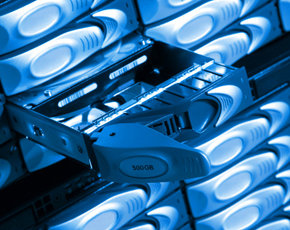Dell has announced an upgrade to its Dell Compellent Storage Center SAN operating system (OS) that nudges the array into enterprise SAN territory. The company also said changes to the Storage Center OS laid the ground for all-flash arrays or array modules.
Historically a mid-range SAN player, Compellent, bought by Dell in early 2011, has made a series of OS and firmware upgrades in the past 11 months that culminate in the announcement at Dell Storage Forum in Paris of Storage Center version 6.3.

The company said Dell's Compellent arrays are ready to play in the enterprise SAN market and claims a 100% IOPS (input-output operations per second) increase, an 87% decrease in controller latency and 16 Gbps Fibre Channel connectivity.
Since early 2012, Dell has incrementally upgraded the Storage Center OS. In January, it moved from 32-bit to 64-bit capability; in June it ported the OS to a Dell controller from third-party hardware.
"Version 6.3 is a game changer for us. It moves us into the tier one storage supplier space with the first 16 Gbps Fibre Channel end-to-end connectivity and enterprise-class synchronous replication," said Dell vice-president and general manager Darren Thomas.
Dell looks to "tier 0.5" for all-flash array
Most storage companies are moving towards the all-flash array for high-IOPS (input-output operations per second) tasks such as online transaction processing and virtual environments. Start-ups have arisen to meet the need and big suppliers have bought flash specialists to augment their flash strategy.
Dell has not made these moves yet, but sees the day when it will buy or develop the capacity for an all-flash array located between servers and main arrays, at "tier 0.5", as described by Dell vice-president and general manager Darren Thomas at Dell Storage Forum in Paris.
"Putting flash in the server is better than putting it in an array. As soon as you connect via Fibre Channel or iSCSI you slow things down immediately. And there's the cost. Currently an all-flash array costs $100,000 to $150,000. A server with flash is, say, $36,000," said Thomas.
"So, do you need flash in an array a tier down from the servers? You will do when servers get so fast that they need to drain data to keep working properly," he added. "For all of 2013, server flash can be kept up with by a Compellent array, but when servers reach one million IOPS you'll need a tier 0.5 between the servers and the main array."
"Moving to 64-bit addressing gave us the potential to double memory in the controller. The new Dell hardware allowed us to deliver on that. Then we moved from a single processor to three CPUs with multi-threading. Those two things together lit it all up," he added.
Version 6.3 will be available generally from March 2013 in Dell Compellent products and as a download to upgrade existing controllers.
Dell Compellent SANs can scale to around 1.5PB capacity, which puts it in the same ball park capacity-wise as smaller enterprise SANs, such as EMC's VMAX 10K and DMX-4, HP's XP and some of its 3PAR arrays, as well as IBM's DS series.
Dell Compellent SANs with Storage Center 6.3 may well be the first with 16Gbps Fibre Channel connectivity, but also have 10Gbps Ethernet connectivity for Fibre Channel over Ethernet (FCoE) or iSCSI.
Where Compellent falls short of most enterprise SAN competitors is on port count. Port configuration is via six PCIe card slots with four ports per card that must be shared between front-end connections (to switches and servers) and back-end connections to disk drives.
Bob Fine, Dell product marketing director and former Compellent executive, said he did not see this as a major obstacle at present because port counts can be expanded via storage director switches, that efficiencies of input/output operations mean the physical backplane in the controller won't be over-taxed, and that customers are not demanding the hundreds of ports available in other enterprise SAN products.
"For many configurations we're dealing with changed blocks [rather than entire files] across many spindles, and therefore efficiencies that mean we don't need massive pipes," he said.
"Physical port count is important and we're always looking at ways to give greater port density. But, our customers don't report this as their biggest obstacle and we can connect via front-end switches anyway," he added.
Fine also talked about Storage Center's readiness for all-flash array capability, or at least all-flash modules in arrays. He said the upgrades to the OS made this year had laid the ground in terms of flash capability.
Read more on all-flash arrays SSD users debate hybrid versus all-flash arrays at SNW NetApp has no plans for all-flash array, says CTO Jay Kidd All-flash storage systems: Types and use cases Tegile adds all-flash array to multiprotocol storage lineup Skyera releases all-flash array for $3 per gigabyte All-flash array products take aim at virtualisation I/O demands
Traditional storage arrays were built for the physical characteristics of spinning disk, but flash drive operations require faster working and entirely different modes of working with read, write and erase.
In the past year, several all-flash start-ups have achieved prominence, such as Violin Memory and Pure Storage. Big storage suppliers have also entered the fray with acquisitions, with EMC buying XtremIO, IBM acquiring Texas Memory Systems, and Hitachi Data Systems recently adding a flash storage module to its VSP SAN arrays.
All target a market for high input/output operations per second (IOPS) operations, such as online transaction processing, database operations and virtual server and desktop environments.
"Flash is part of our architecture," said Fine. "With a faster controller and 64-bit architecture we will be able to accommodate it, but it's a near-term to mid-term plan. The changes in Storage Center 6.3 give us the firmware to go forward on that."





